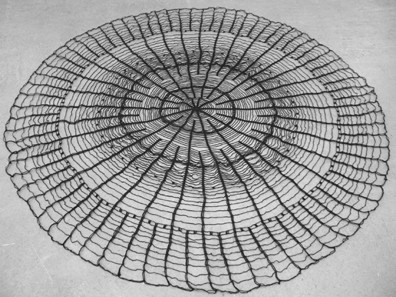Šejla Kameric
27 Jan - 13 Mar 2010
ŠEJLA KAMERIC
27.01.–13.03.2010
In her works, the Bosnian artist Šejla Kamerić deals with the history and traditions of her native country, where the traces of the Balkan wars and the Srebrenica massacre of 1995 remain anchored in the people’s collective memory. Kamerić’s Bosnian Girl (2003) is one of the most important artworks from the start of the third millennium reflecting the post-war situation in Eastern Europe. Aesthetics and history are merged in a way that reveals a dichotomy between visual manipulation in mass media (war reporting) and the actual events and experiences of local citizens. The self-portrait of the artist sullied with graffitied insults from a Dutch soldier depicts the manipulation of history, raising a range of issues regarding media representation.
This attempt to explore the boundaries between aesthetic relevance and the coherence of content is also characteristic of the approach evident in Kamerić’s latest artworks, presented to the public for the first time in Gallery Krobath. In these works, the artist uses traditional handicraft – crocheted doilies to be precise or at the very least creations that would function as doilies. Here Kamerić is alluding to a tradition considered to be a typically female craft, while at the same time allowing traces of male dominance and menace to merge. In so doing, she reproduces gender-specific perspectives, made visible through the particular aesthetic she chooses for her works.
The artworks presented in Gallery Krobath can be categorised into two groups: One comprises large circular pieces of crocheted works which can be spread on the floor or mounted on the wall. The pieces are primarily made of black thread and have flaws and frayed fringes, resembling cobwebs and thus evoking a feeling of menace and distracting from the beauty of the traditional handicrafts. These works could also be viewed as an allusion to military clichés, as they are reminiscent of reticles and targets. The soft material of the works, consisting of wool and thread, adds an ironic twist to this interpretation.
While the circular pieces were made for this exhibition, the second group of works consists of objects that had already been crafted: rectangular white crochet pieces, which Kamerić used as a canvas for black, graffiti-like elements. The doilies, which usually decorate tables and sideboards, are thus torn from their original context and transformed into artefacts. By so doing, Kamerić introduces a new artistic dimension to traditional handicraft.
This is also a reference to Kamerić’s earlier work Bosnian Girl, where she took the soldier’s graffiti and placed it into a new artistic context. Kamerić’s latest work once again breaks the cultural codes of traditional gender attributions and places the issue of gender-specific activities in a wider context of image and material production.
Text: Walter Seidl
(English translation: Mandana Taban)
27.01.–13.03.2010
In her works, the Bosnian artist Šejla Kamerić deals with the history and traditions of her native country, where the traces of the Balkan wars and the Srebrenica massacre of 1995 remain anchored in the people’s collective memory. Kamerić’s Bosnian Girl (2003) is one of the most important artworks from the start of the third millennium reflecting the post-war situation in Eastern Europe. Aesthetics and history are merged in a way that reveals a dichotomy between visual manipulation in mass media (war reporting) and the actual events and experiences of local citizens. The self-portrait of the artist sullied with graffitied insults from a Dutch soldier depicts the manipulation of history, raising a range of issues regarding media representation.
This attempt to explore the boundaries between aesthetic relevance and the coherence of content is also characteristic of the approach evident in Kamerić’s latest artworks, presented to the public for the first time in Gallery Krobath. In these works, the artist uses traditional handicraft – crocheted doilies to be precise or at the very least creations that would function as doilies. Here Kamerić is alluding to a tradition considered to be a typically female craft, while at the same time allowing traces of male dominance and menace to merge. In so doing, she reproduces gender-specific perspectives, made visible through the particular aesthetic she chooses for her works.
The artworks presented in Gallery Krobath can be categorised into two groups: One comprises large circular pieces of crocheted works which can be spread on the floor or mounted on the wall. The pieces are primarily made of black thread and have flaws and frayed fringes, resembling cobwebs and thus evoking a feeling of menace and distracting from the beauty of the traditional handicrafts. These works could also be viewed as an allusion to military clichés, as they are reminiscent of reticles and targets. The soft material of the works, consisting of wool and thread, adds an ironic twist to this interpretation.
While the circular pieces were made for this exhibition, the second group of works consists of objects that had already been crafted: rectangular white crochet pieces, which Kamerić used as a canvas for black, graffiti-like elements. The doilies, which usually decorate tables and sideboards, are thus torn from their original context and transformed into artefacts. By so doing, Kamerić introduces a new artistic dimension to traditional handicraft.
This is also a reference to Kamerić’s earlier work Bosnian Girl, where she took the soldier’s graffiti and placed it into a new artistic context. Kamerić’s latest work once again breaks the cultural codes of traditional gender attributions and places the issue of gender-specific activities in a wider context of image and material production.
Text: Walter Seidl
(English translation: Mandana Taban)

